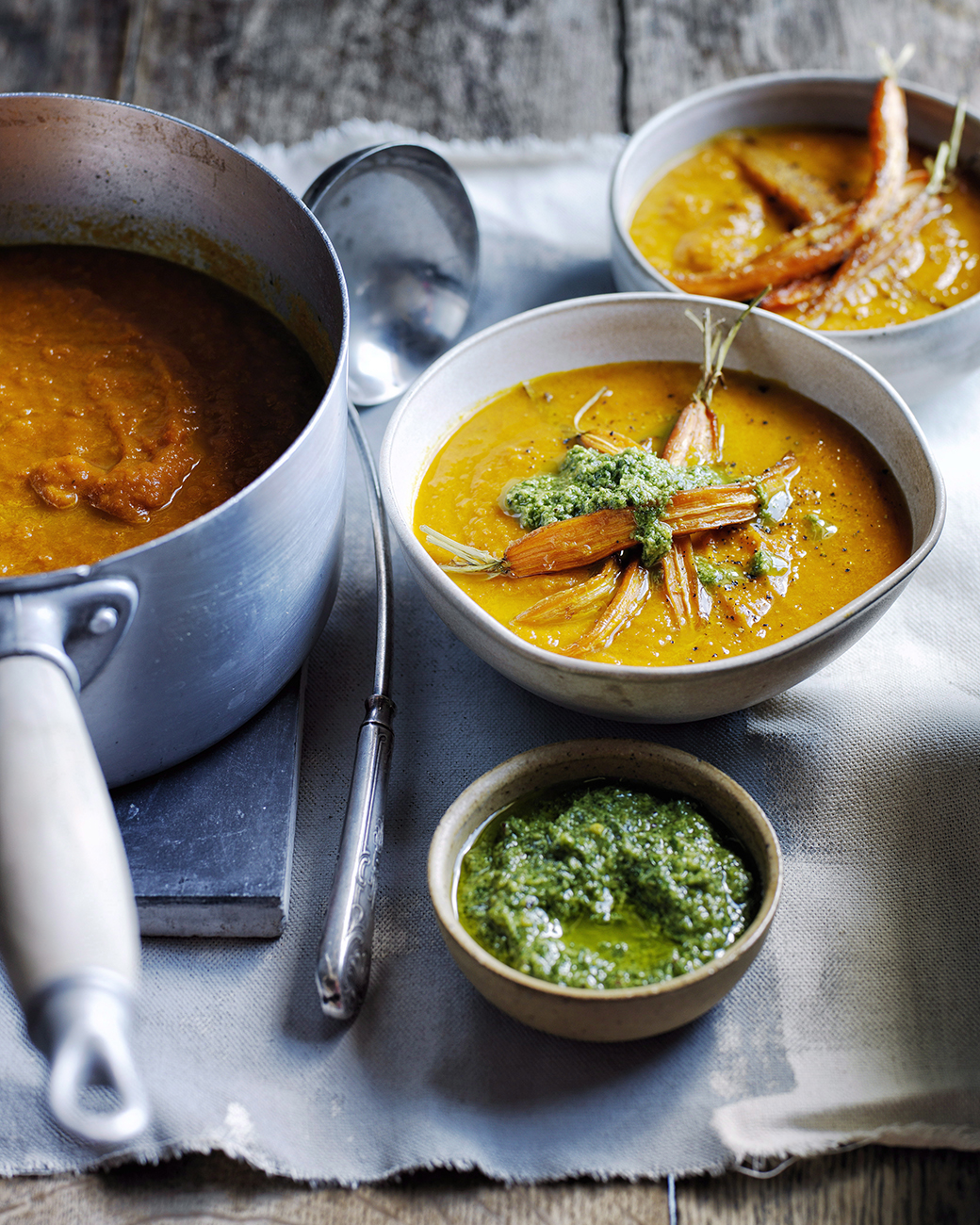Entertaining is a doddle if you’ve got a huge budget – I think anybody can be a good cook if money is no object.
Gosh, you could just buy oysters on the half shell or even a bucket of crayfish and an eye fillet of beef.
I’d go crazy at the greengrocers or probably some fancy little farmers market with loads of gorgeous salad greens and punnets of every kind of sweet delicious berries.
Hardly anything needs to be done with fabulous ingredients like these – just a minute under the grill or on each side in a hot pan, a splash of olive oil, a squeeze of fresh lemon and dusting of icing sugar and, hey presto, dinner is served.
However, real life has dictated that I need to be more the kind of cook that’s quick, smart and economical. A cook who can rustle up a tasty dinner from seemingly nothing at all.

A well-stocked pantry is a crucial part of economical cooking Image: Bauer Syndication
I call this entertaining on the “loaves and fishes” principle, which is feeding a crowd by making the most of what you’ve got available and to hand.
I’m not talking magic tricks here, just a bit of clever supermarket shopping, planning ahead, having a well-stocked pantry and, yes, if possible, a little garden space – these are the ways I cope with the challenge. And, no, this ability isn’t found in your DNA.
Smart cooking is a learned skill, you’re not born with the ability to do it, and like all good things, practice makes perfect.
Over the years I’ve done enough faffing around in the kitchen to refine this ability, and I’m always happy to share a few of my tips and tricks for both entertaining and for feeding the family.
When it comes to weekday meals, I think the first thing is to schedule in a bit of thinking time and to draw up even the vaguest of plans, so that when you come home from work feeling tired and exhausted, the brain cells don’t have to focus too much on the age-old question of “what’s for dinner tonight?”
I find that Sunday evening is a good time to draw up a meal plan for the coming week.
It may seem old-fashioned and like something your granny did, but it actually works, and it doesn’t have to be complicated.
Having a quick look in the freezer and pantry first to see what you already have, then jotting down a little list of meal ideas and the extra ingredients you need to buy, goes a long way towards easing the meal planning.
Like many New Zealanders, we as a family are eating more and more plant-based meals. So a good start is working out a few ideas along these lines.
I also like at least one pasta dish a week. My favourite at the moment is a lasagne lookalike, replacing some of the pasta with thinly sliced lengthwise zucchini or red peppers for layering.

Image: Bauer Syndication
Knowing how to make a decent cheese sauce is one of the handiest skills to master and one I’ve taught both my kids in their going-flatting, basic cooking lessons. (See my standard recipe, below.)
I’m very influenced by the Italians, who are great entertainers.
In Italy, you’re often invited to dinner where the meal is about 10 courses long. It’s not an overladen, groaning table of food you’re presented with, but rather a long-lasting, eaten-in-leisurely stages meal.
The salad is always a separate course and they often just serve a single type of salad leaf, such as red radicchio, or a handful of endive or rocket leaves with fruity, fresh green olive oil as the dressing.
Crusty bread and more olive oil is another course and then perhaps a slice of fresh pear and little wedge of creamy goat’s cheese for another.
Dessert can be simply a few strawberries with brown sugar and a swirl of sour cream or a little thin slice of cake with fruit purée, or even a delicious chocolate truffle.
You don’t ever get up from that table feeling so full you can hardly move – in fact, you’re more than likely to hit the dance floor in true Italian style!

Image: Bauer Syndication
Doing the unexpected when entertaining is a good trick.
For example, instead of serving the traditional and, dare I say passé, starter, main and dessert, try a soup and a salad or two or three smaller entrées and a hearty pudding.
As the weather cools, soup-based meals become enticing and anything can be made into soup.
My favourite is to roast off lots of vegetables, especially those last few stragglers from the crisper drawer – think a couple of carrots, pumpkin and a seen-better-days parsnip. The roasting process gets rid of water and in doing so concentrates flavour.
I usually whiz it all up with good-quality chicken or beef stock, or even milk, and season super-generously with lots of freshly ground black pepper. Served in rustic bowls with crusty bread, nothing is nicer or better conveys the message that this is home-made with love.

Image: Bauer Syndication
Having good supplies of herbs and spices is useful – you don’t need lots, but they do need to be fresh, so have a regular culling of what’s in your pantry and toss out the dated stuff.
I love the Tuscan blend of rosemary, thyme, lemon zest and pepper, and I’m also never without tubes of chilli paste and grated ginger as well as store-cupboard ingredients like chutneys and relishes, capers, pickled onions and gherkins and cans of coconut cream and chopped tomatoes.
In the early summer when my fresh coriander plants are lush, just before they bolt clean away, I pick all the leaves off and freeze them in ice-cube trays with water. Each block is crammed with coriander but the water prevents it going black. I just toss a whole herby ice cube straight into curries and stir-fries for that lovely fresh coriander zing.
It’s especially handy in the middle of winter, when less flavoursome, hydroponic coriander costs a small fortune.
A simple sauce can make all the difference
Good easy sauces are often the highlight of a meal and can lift the day-to-day plain old chicken breast or pork cutlet to a new culinary high.
One of my faves is a creamy blue cheese number, which is just so rich but also so rewarding. It’s simply a segment of Blue Castello cheese melted with a 300ml bottle of cream – it’s one of my easiest but most frequently used recipes and will score you heaps of Brownie points in the culinary stakes.

Image: Bauer Syndication
It’s also worth learning to make a really simple bread.
My focaccia recipe is amazing (she says modestly) and if you have a KitchenAid or similar big mixer you don’t even need to get your hands in.
Ditto for learning how to make your own pasta. It’s so simple: 1 egg to 100g of high-grade or pasta flour. I can turn a couple of paua or perhaps two or three scallops into ravioli and be able to feed a crowd – serve with a sauce made of butter-sizzled fresh sage leaves and you have a winner.
The same principle applies to rice paper rolls, wontons and dumplings.
I could write on and on about how to entertain simply, smartly and in true peasant style, but actually I have already done that in my cookbooks, so just get hold of them for loads more ideas.
When I’m entertaining, I’m quite happy for my guests to think I’ve been home all day, slaving away in the kitchen cooking their dinner (not) – and letting them think that is perhaps my greatest trick of all!
Jo’s cheesy sauce
50g butter
2 tablespoons flour
good dollop of Dijon-style mustard
salt and pepper
2-3 cups milk
handful of grated tasty cheese or, even better, parmesan
Melt the butter in a small saucepan.
Stir in the flour and a good dollop of Dijon mustard.
Add a generous amount of salt and pepper, then whisk in the milk.
Add the grated cheese. Stir continuously with a wire whisk and add extra milk to get the sauce to the desired consistency (make it thicker for cauliflower cheese and thinner for macaroni).




